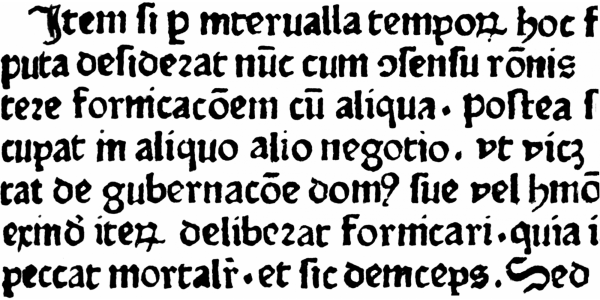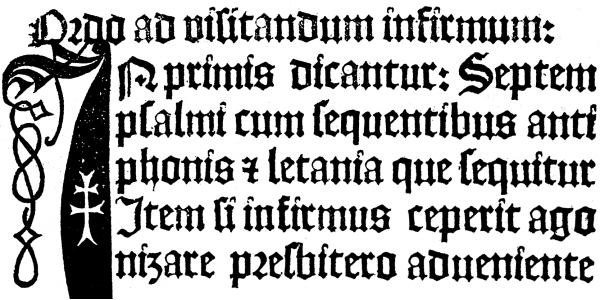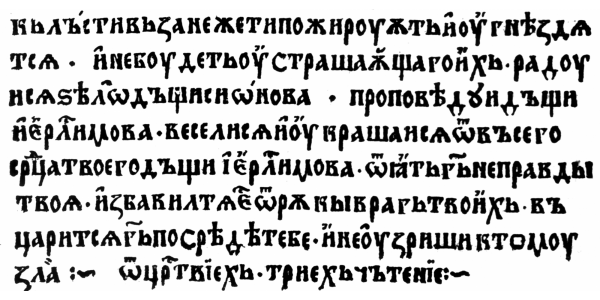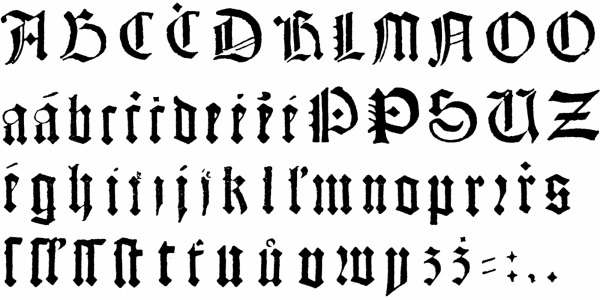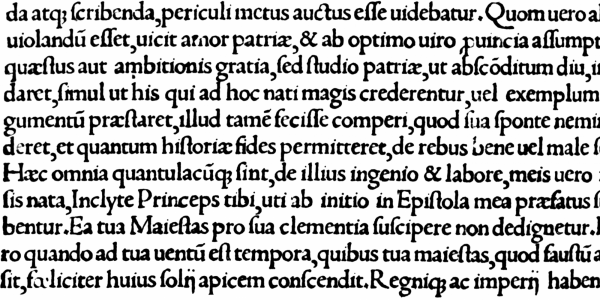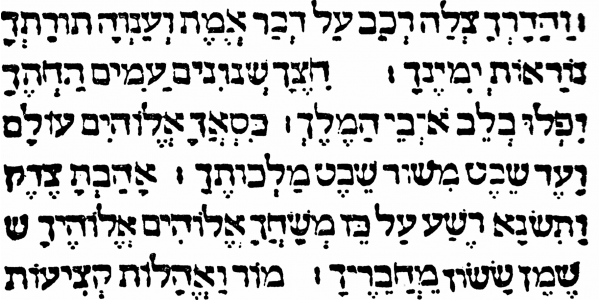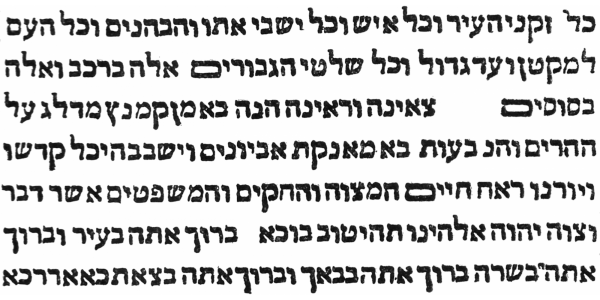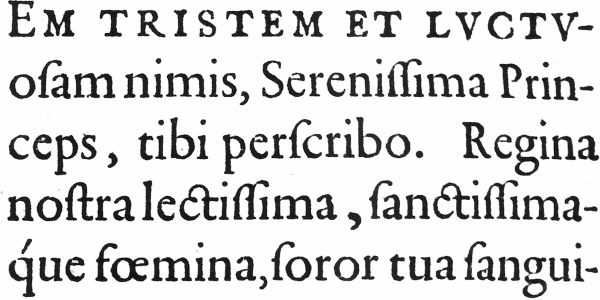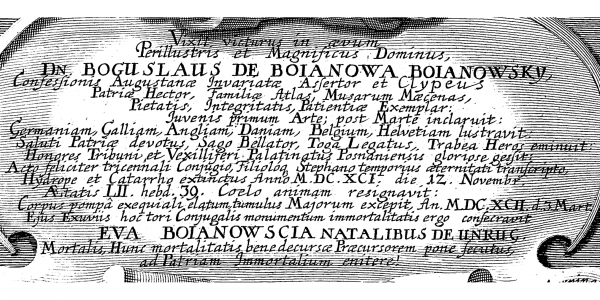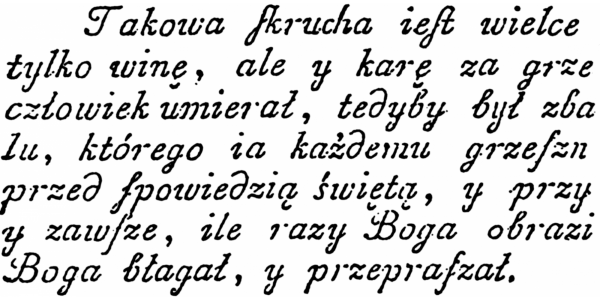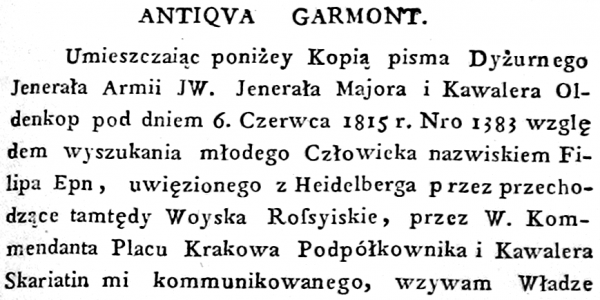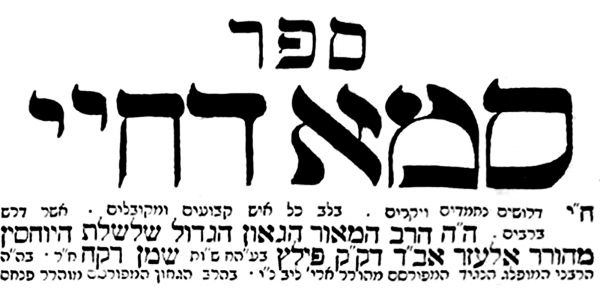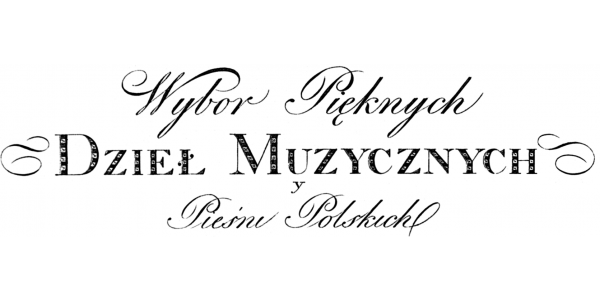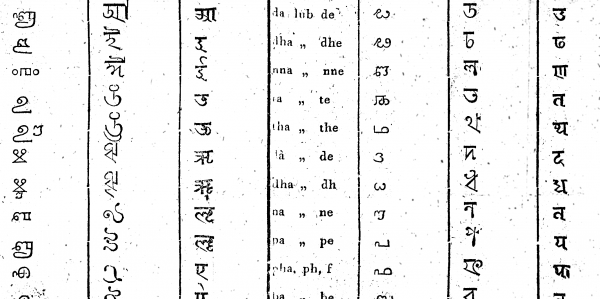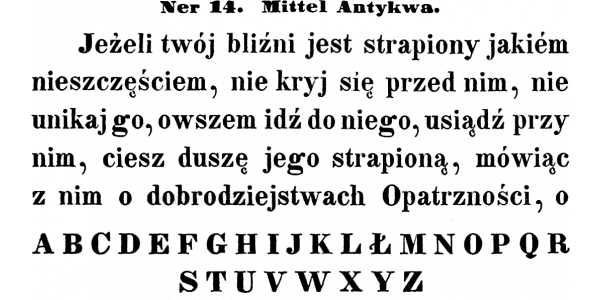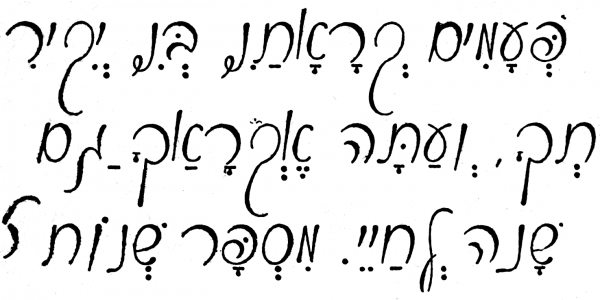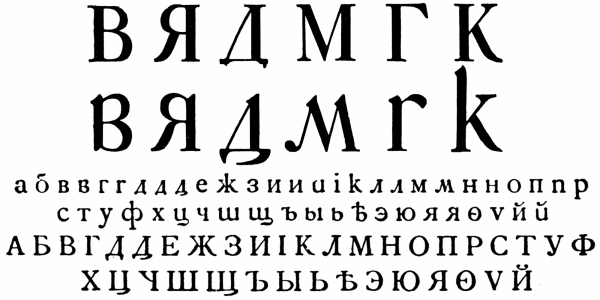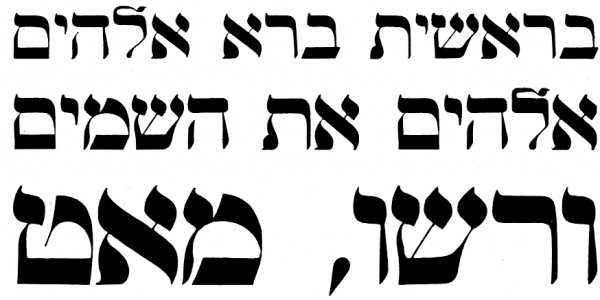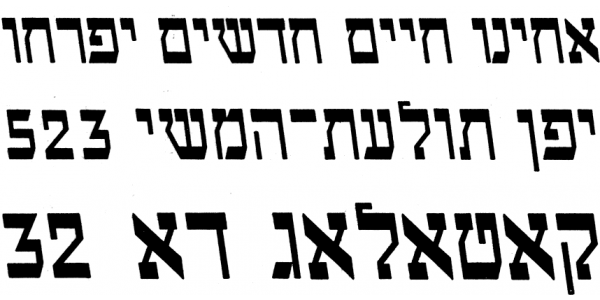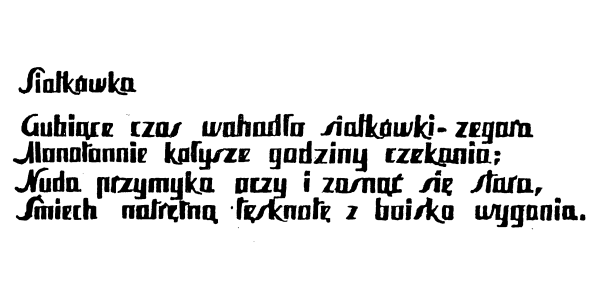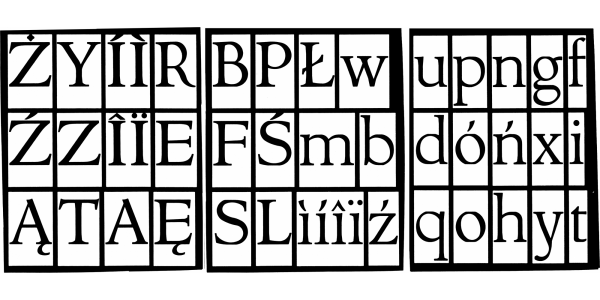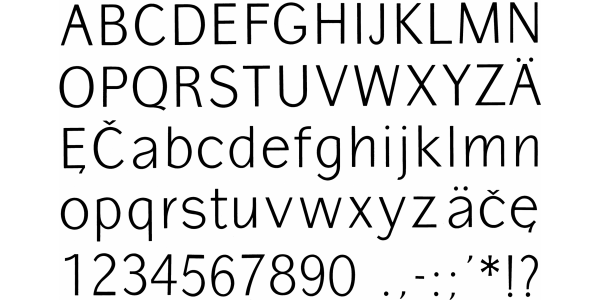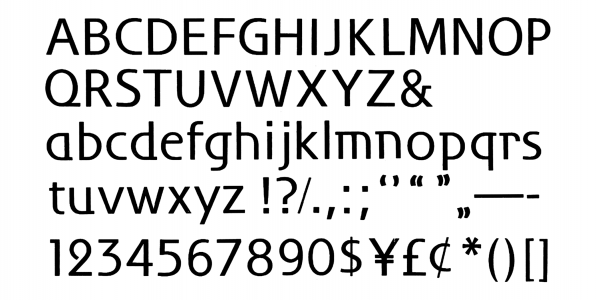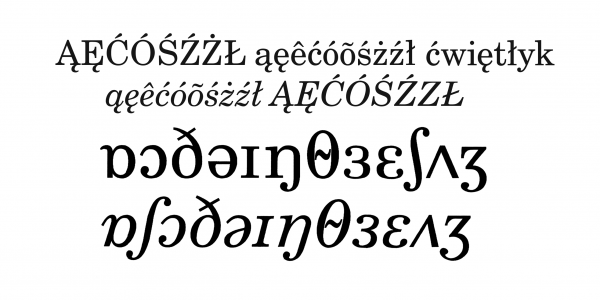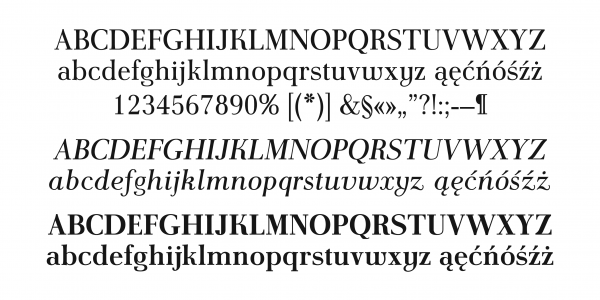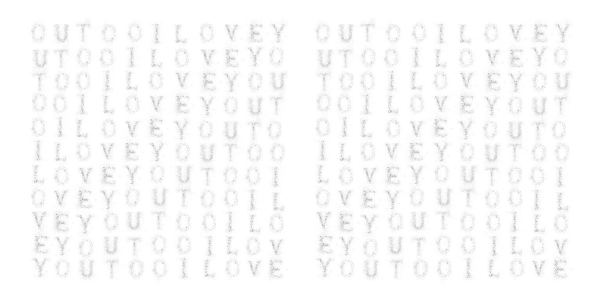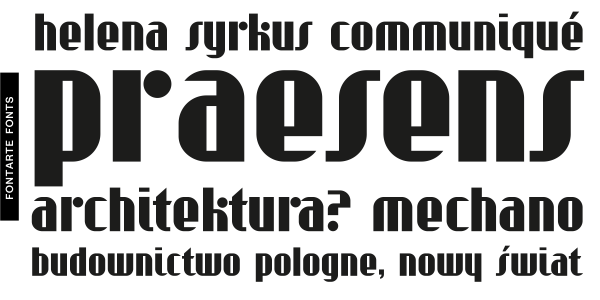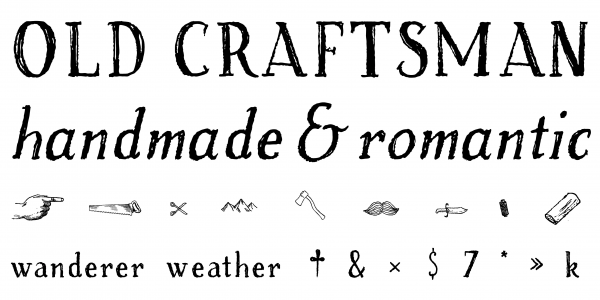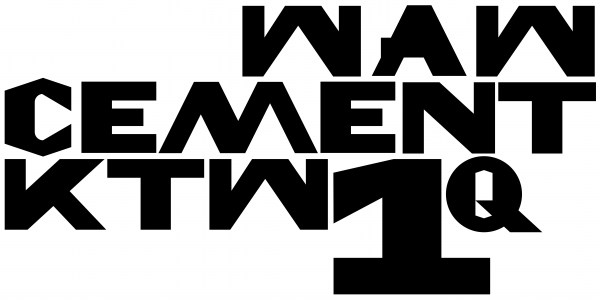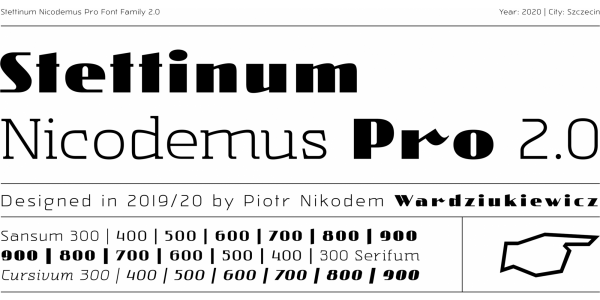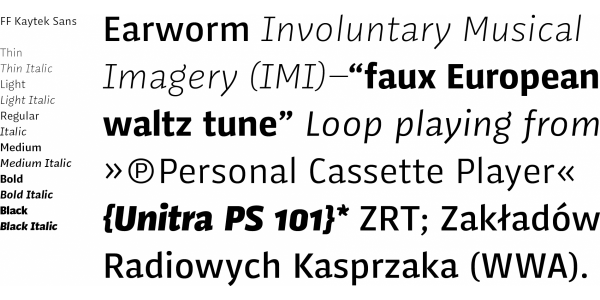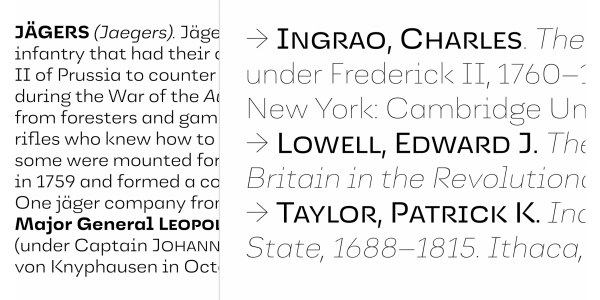History of Polish typefaces in a nutshell
Incunabula (1474–1500)
The period of the 15th century prints, i.e. incunabula (Latin in cunabulis = in a cradle, in nappies). The earliest prints, from the time of the Johannes Gutenberg's workshop until the end of the 15th century, are also called paleotypes.
The function, form and technology of making printing types, remained fundamentally unchanged for five hundred years. The process came to life during the work of Johannes Gutenberg (ca.1399–1468), who since as early as the times of the Renaissance was called ‘the father of printing’. After long-term attempts, the inventor constructed an apparatus for casting permanent types – metal matrices which ensured the repeatability of identical precise casts. He also developed a practical method of composing text columns and printing them with the use of an appropriate press. Gutenberg's largest and most famous typographic work was the two-volume Bible (known as the 42-line Bible) printed in Mainz in the years 1452–1455 – the first book in Europe to be printed with movable type.
The vast majority of incunabula had unprinted spaces on their pages for rubricators and illuminators, decorating the prints with hand-painted initials or ornaments. In Poland, the printing is done by six typographers in Kraków, Wrocław, Gdańsk, Chełmno Pomorskie and Malbork.
Examples of typefaces from this period:
Designers of this period
Early classical printing (1501–1550)
In the 16th century, the printing industry was systematically departing from the imitation of the form of medieval manuscripts. Woodcut initials and illustrations printed simultaneously with the typeset text was used often.
The most important printing and publishing center was Kraków (Haller, Ungler, Wietor, Szarfenbergs and others). However, the printing was done throughout the Kingdom and Lithuania. Apart from Polish-Latin printing houses, Cyrillic and Hebrew publishing houses were also created. Typographers, just like in the times of incunabula, cast the types on their own, but specialized typefaces were also created by foundries supporting printers both nearby and further away. Polish orthography and letter shapes were developed. In determining the form of the Polish alphabet, works unambiguously related to the printing practice and casting of types play a decisive role. Significant changes in the drawing of letters and diacritical marks representing the sound of vowels and consonants were made throughout the 16th century by printers, mainly from Kraków, Wrocław and Königsberg, basing on the published treatises (by Zaborowski and Murzynowski). They used them in the texts of their own works, and the simple fact of duplicating them made the patterns become an accepted standard.
Examples of typefaces from this period:
Designers of this period
Mature classical printing (1551–1700)
There noteworthy printing houses were based in Kraków (Wirzbięta, Rodecki, Sternacki and others) and Gdańsk (including Rethe, Hünefeld, Heweliusz). In 1585, the Radziwiłł printing house in Brest-Litovsk published the dissentative Bible, translated and edited by a dozen authors, an excellent monument of the Polish language. In 1594, Januszowski published Nowy Karakter Polski in Kraków, with the ortography of Kochanowski, Górnicki and his own, printed in the original Polish typeface.
The 17th century was the time of misfortunes and wars (with Moscow, Turks, Cossacks, and of the Swedish Deluge). Printing houses were established in many places (e.g. the first permanent publishing house in Warsaw), but in terms of printing aesthetics, their production was mostly low. The first issue of Merkuriusz Polski Ordynaryjny - the oldest periodical Polish newspaper – set in upright serif and schwabacher, was published in 1661, in the Kraków printing house of Jan Aleksander Gorczyn. Typographers introduced copper engraving more and more often. In their publications, copperplate prints and convex forms were combined in a variety of ways, e.g. in the collection of engraved sky maps by Jan Heweliusz Prodromus astronomiae ... et Firmamentum Sobiescianum (1690)
Examples of typefaces from this period:
Designers of this period
Late classical printing (1701–1800)
At the beginning of the century, Paweł Pater opened a printing house and a school in Gdańsk, where production of types, printing and bookbinding were taught. His book Typis literarum... is a Latin-German textbook covering, among others, casting and printing tools and differentiation of typefaces. In Warsaw, the publishing movement related to the Enlightenment trends of the times of king Stanisław August Poniatowski and the Four-Year Sejm (the printing houses of Gröl, Mitzler de Kolof, Dufour, Bohomolec, Potocki, Mostowski and the musical printing house of Engel) was developing. The pretty prints of Michał Gröl gained a general reputation. The types of Piarist priests and missionaries as well as Podebrański and Zawadzki were created.
Examples of typefaces from this period:
Designers of this period
From craft to industry (1801–1850)
Printing was developing rapidly in all three partitions of Poland. Type foundries were established in Warsaw (Dąbrowski, Benecke, Glücksberg, Gissernia Skarbowa), as well as in Lviv and Kraków. The first lithographic printing houses were also established (Siestrzyński, Chodkiewicz). Natan Glücksberg's participation in the Warsaw Exhibition of Fine Arts in 1821 and his efforts to gain acceptance among artists is the first attempt to ennoble printing – typography as a field of artistic creativity. In 1833, the first high-speed machine in the country was put into operation at the printing house of Bank Polski in Warsaw. Glücksberg published Ząbkowski's Teorya sztuki drukarskiej (1832, ‘Theory of printing art’), and a few years later Samuel Orgelbrand established a famous publishing and printing company. In Krakow, Stanisław Gieszkowski printed the first volume of Wiszniewski's Historia literatury polskiej (1840, ‘Polish literature history’).
Examples of typefaces from this period:
Designers of this period
Mechanisation of the printing processes (1851–1900)
Thanks to the stormy development of the press and readership, printing houses were installing fast machines, and in Kraków, Żegota Wywiałkowski published a textbook Wartkotłocznie (1858) in the Printing House of "Czas" (Time). At the end of the 19th century, Foucher and Küstermann system type casting machines (producing 30-50 thousand types a day) were installed in the Orgelbrand and Ungra foundries. From 1878, the newspaper "Kurier Warszawski" was printed on a modern rotary press. In 1899, the first machine for automatic typesetting, the so-called “monolina”, was purchased for the National Printing house in Kraków.
Examples of typefaces from this period:
Designers of this period
From letterpress to offset printing (1901–1950)
Along with the technical progress, the awareness of the social role of typography was gradually growing, not only in its aesthetic but also functional aspects. As early as 1905, in the Congress Kingdom, the school textbook regulations set the maximum number of fifteen letters in one square centimeter of text. The foundries of Idźkowski, Jeżyński, Koziański and Konat were operating in Warsaw at the time. In 1914, the first linotypes started to be used in Kraków and since then typesetting mechanization gradually progressed. Linotypes and monotypes were widely used for the so-called hot composition. In typography before World War I and the interwar period, several artistic trends are visible that were characteristic of those years: with the magazine "Chimera", the so-called Polish decorative art, avant-garde of constructivism and futurism, and Art Deco. In 1927, printing was officially included in the industry category. After World War II, the state-owned company Odlewnia Czcionek (Type Foundry) was established on the basis of the Idźkowski i S-ka company, which received the surviving matrices and types from other Warsaw foundries.
Examples of typefaces from this period:
Designers of this period
Final period of traditional printing methods (1951–1985)
The peak period of Gutenberg-initiated letterpress printing technology and its almost complete supersession by offset printing. Typesetting machines (linotype, monotype) were becoming a relic of the past, type foundries were going downhill. Phototyping techniques were gradually developed, in which texts were created on photosensitive materials, ready for the preparation of offset printing plates. Next generations of phototypesetting machines were created: from primitive ones, in which the letter carriers were negative photomatrices, to electronically controlled photocomposers with bitmap computer types. The qualitative and quantitative avalanche development of mass information, started in the interwar period, continued. The printed word competed for the reader's attention with other media, and reading speed and comprehension became an important part of the communication process. Typography, understood as the ability to use typefaces and designing prints, is taught at universities in many countries, including Poland.
Examples of typefaces from this period:
Designers of this period
- Helena Nowak-Mroczek
- Andrzej Heidrich
- Marek Sigmund
- Tadeusz Szumilas
- Bogdan Żochowski
- Henryk Sakwerda
- Bronisław Zelek
- Zygfryd Gardzielewski
- Adam Półtawski
- Stefan Bernaciński
- Władysław Brykczyński
- Bolesław Penciak
- Jerzy Desselberger
- Elżbieta Krużyńska
- Małgorzata Budyta
- Maria Eska
- Maria Nowak
- Jerzy Janiszewski
- Roman Duszek
Beginning of the digital era (1986–1999)
In the mid 1980s, the Desktop Publishing Revolution took place in the US and Western European publishing industries. Apple Macintosh computers, and later PCs with Microsoft Windows, editor and illustration programs (QuarkXPress, PageMaker, Calamus, CorelDraw, FreeHand, Illustrator), as well as PostScript – a universal language for controlling printers and platesetter developed by Adobe - made the publishing process move from typesetters to designers’ desks. Professionals and amateurs alike used the Altsys Fontographer editor to create ready-to-use digital fonts in Type 1 and TrueType formats.
In Poland after 1989, the place of bankrupting state typesetting, printing and publishing houses was taken by private companies run mainly by "computer scientists" rather than graphic designers or typographers. Polish DTP operators gained access to hundreds of new digital fonts containing only western European characters. Few enthusiasts (Jackowski, Ryćko, Szczypka, Tatarkiewicz, Tomaszewski, Czapnik, Kenig) started to supplement and expand fonts with Polish diacritics and to translate the interfaces of typesetting software to Polish. There was only a handful of original typefaces designed in the country. In the 1990s, Polish books, newspapers, signboards, advertising leaflets, catalogues and posters were created hastily, and several robust packages of Western fonts with added Polish characters were used as the source of typographic material. Today, the typographic chaos of this period is referred to as "typo polo".
Examples of typefaces from this period:
OpenType Fonts and digital text (2000–2015)
The beginning of the 21st century was the beginning of the digital circulation of text. Windows 2000, Word, InDesign and the early WWW bring order to digital text encoding: thanks to the introduction of Unicode standard, transferring Polish digital text between different operating systems no longer required tedious conversion. The new OpenType format makes it possible for the same font to include characters from different scripts for the first time, as well as typesetting functions such as small caps and ligatures. Large producers (Adobe, FontFont, Linotype, Monotype) and individual publishers of typefaces around the world started to include Polish diacritics in their fonts. The newly emerging online font stores (MyFonts) give Polish graphic designers immediate access to the world's typographic resources – price was the only remaining barrier.
The font editor – FontLab, created in cooperation between US-Russian-Polish software engineers, became the primary tool for the work of typeface designers and producers around the world. Thanks to the Internet and typographic conferences (ATypI, TYPO Berlin), Polish enthusiasts of digital type design establish contacts with their colleagues abroad. After several decades of Polish typographic stillness, in the first decade of the 21st century, self-taught pioneers (Otto, Nowacki, Frankowski, Dziedzic) create digital replicas of existing designs as well as completely new typefaces. Thanks to the efforts of prof. Kochnowicz, this group was soon to be joined by graduates of the University of Arts in Poznań, followed by subsequent designers, educated in other centers in Poland or at universities in The Hague and Reading.
Examples of typefaces from this period:
Designers of this period
- Michał Jarociński
- Maciej Włoczewski
- Mateusz Machalski
- Franciszek Otto
- Radek Łukasiewicz
- Roch Modrzejewski
- Aleksandra i Daniel Mizielińscy
- Robert Jarzec
- Anna Štepanovská
- Botio Nikoltchev
- Łukasz Dziedzic
- Adam Twardoch
- Błażej Ostoja Lniski
- Artur Frankowski
- Magdalena Frankowska
- Maciej Majchrzak
- PBD.pl
- Sebastian Cabaj
- Viktoriya Grabowska
- Edgar Bąk
- Janusz Marian Nowacki
- Zuzanna Rogatty
- Mikołaj Grabowski
- Henryk Sakwerda
- Maciek Sobczak
- Paweł Osial
- Andrzej-Ludwik Włoszczyński
- Piotr Woźniak
Variable fonts and screen typography (2016–2024)
From the time of Gutenberg, typography was synonymous with printing and paper. However, recent years have witnessed the rapid development of computer screens and mobile devices as a medium through which text reaches recipients – from e-books to short texts on social media and instant messaging. Web browsers can display complex typesetting with any fonts embedded in the HTML code. Thanks to Google Fonts, the Polish ‘Lato’ font family is the most read screen typeface in the world created by an independent team (Dziedzic, Twardoch, Nikoltchev).
In 2016, at the ATypI conference in Warsaw, the world's largest computer companies are presenting a new version of the OpenType font format, which adds the ability to smoothly transform letter shapes. Internet browsers are the first programs that fully support variable fonts. For the first time, it is the screen, not the paper, that is the main medium of typographic innovation. Polish typography is doing well. There are several stores on the market offering typefaces created in Poland (Capitalics, Threedotstype). Some Polish designers publish their typefaces at the world's largest publishers. Multi script typefaces are created in Poland – fonts with Cyrillic, Greek, Arabic and Hebrew. Every year, the most prolific authors (Machalski, Jarociński, Mizieliński) are joined by new adepts in the art of designing letters. They cooperate with type designers and typographers from around the world, creating both simple display fonts, as well as complex typographic systems.
Examples of typefaces from this period:
Designers of this period
- Maciej Włoczewski
- Mateusz Machalski
- Andrzej Heidrich
- Leszek Bielski
- Michał Jarociński
- Ludka Biniek
- Ania Wieluńska
- Borys Kosmynka
- Przemysław Hoffer
- Wojciech Freudenreich
- Aleksandra Lampart
- Joanna Angulska
- Kaja Słojewska
- Franciszek Otto
- Beata Kurek
- Piotr Wardziukiewicz
- Radek Łukasiewicz
- Roch Modrzejewski
- Szymon Sznajder
- Aleksandra i Daniel Mizielińscy
- Patryk Gmerek
- Barbara Bigosińska
- Maciej Połczyński
- Dominika Nika Langosz
- Błażej Ostoja Lniski
- Artur Frankowski
- Magdalena Frankowska
- Maciej Majchrzak
- PBD.pl
- Zofia Janina Borysiewicz
- Marian Misiak
- Bronisław Zelek
- Jan Estrada-Osmycki
- Adam Jagosz
- Viktoriya Grabowska
- Przemysław Zięba
- Sebastian Cabaj
- Kacper Janusiak
- Zuzanna Rogatty
- Jacek Walesiak
- Mikołaj Grabowski
- Paweł Osial
- Agnieszka Cieślikowska
- Przemysław Kopczyk
- Konrad Łukasiak
- Paweł Schulz
- Izabela Lewkowicz
- Filip Tofil
- Adam Półtawski
- Michał Berger
- Małgorzata Bartosik
- Wiktor Buksza
- Wojciech Regulski
- Grzegorz Samson
- Kuba Rudziński
- Piotr Ciesielski
- Katarzyna Szykowna
- Antoni Kwiatkowski
- Grzegorz Komarec
- Honza Zamojski
- Andrzej-Ludwik Włoszczyński
- Adam Twardoch
- Andrzej Tomaszewski
- Elżbieta Krużyńska
- Michał Gorczyca

